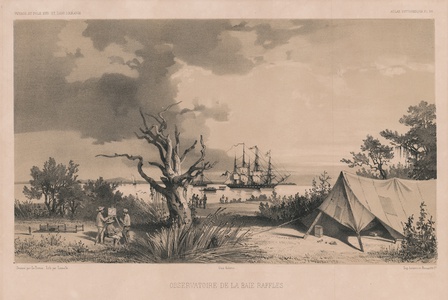| Method | Lithograph with tint stone |
| Artist | after Louis Le Breton |
| Published | Lith par Lassalle. Imprimerie Thierry frères, Paris. Gide, 1842-1846. |
| Dimensions | Image 183 x 312 mm, Sheet 273 x 370 mm |
| Notes |
Plate 116 from Voyage au Pole Sud showing a view of Raffles Bay at the eastern end of Cobourg Peninsula, in the Northern Territory, Australia. This rare view shows the bay stretched out across the scene, two large ships on the water at the centre, the Astrolabe and La Zélée. In the foreground three figures can be seen stood and sat by an easel, a small tent to the right. A large sparse tree is at the centre of the scene with small groups of aboriginal people at the waters edge to the right. This scene was drawn from life by Le Breton during Jules Dumont d'Urville's famous South Pole and Oceania expedition in which Antarctica was discovered as a continent. Raffles Bay was the site of a second attempt at settlement on the northern coastline of Australia but was unsuccessful. Embossed with the blind stamp Gide Editeur Paris indicating that is from the original edition of Voyage au Pole Sud. Louis Le Breton (1818 - 1866) was a French artist. Born in Douarnenez, Le Breton studied medicine before becoming a painter specialising in maritime subjects. Le Breton took part in Dumont d'Urville's second voyage aboard the ship Astrolabe, taking over as the official illustrator when the other died. After returning from the voyage, he began working as an official artist for the French Navy. Jules Dumont d'Urville (1790 - 1842) was a French naval officer and explorer. Born in Lower Normandy, d'Urville joined the Navy aged 17. On his ship the Astrolabe, he explored the south and western Pacific, Australia, New Zealand, and Antarctica, which resulted in the discovery of Antarctica as a continent. Condition: Light toning from previous mount. Small chip to right lower corner. |
| Framing | unmounted |
| Price | £350.00 |
| Stock ID | 52986 |

